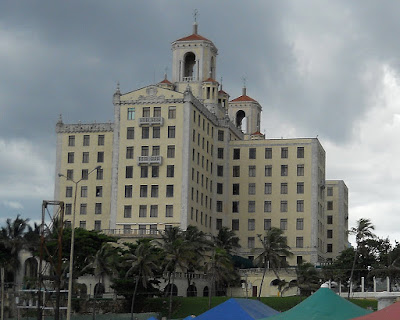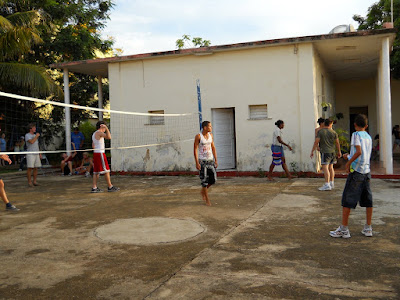 |
| Arriving at the airport in Havana |
 |
| You must pass through customs one person at a time. |
The sun shines bright as we depart the plane and are taken by bus to Cuban customs. Once are visas are approved we are thrown into a chaotic scene of customs agents, baggage handlers and travelers all jostling about. An "aduana" helps us to fill out a customs form for sickness so we can claim our bags.
The baggage claim area is very disorganized because we have no idea which bags match the flight we are on. They are all being thrown onto a single conveyer belt. Folks are jumping across the moving belt and shouting to each other trying to spot a bag they think is theirs. I have never experienced anything like this! About an hour and half later we finally snatch the last bag and move towards the entrance tax station. An entrance tax is charged by the Cuban government on everything from consumer goods to food. Rationing has been ongoing for years so our visits are an opportunity to bring much needed supplies and medicines to the people here. Luckily an "aduana"' identifies us as "americanos con visas religiosos" so we are allowed to leave customs without paying any taxes. As we exit the airport we are surrounded by a sea of faces all waiting to greet friends and relatives.
 |
| Outside the airport. |
 |
| Tired and hot. |
We quickly spot Francisco, the Canon to the Ordinary to the diocese of Cuba. Francisco greets us warmly and then directs us to the church bus. We climb aboard and get our first look at Havana. It is a busy city alive with traffic and pedestrians. There are banners and slogans everywhere promoting "Julio de 26", the anniversary of the Cuban revolution. We arrive at the cathedral and have a quick bite to eat at a sandwich shop around the corner from the cathedral. Carlos,our bus driver takes us on quick tour of Havana to view the downtown and waterfront. I recognize several of the famous hotels along the waterfront from my collection of hotel luggage labels. Hotels like the National and Englaterra were fashionable destinations during the golden age of travel. Carlos also shows us monuments to more recent events like the Cuban Revolution of 1960. As we leave the city all of us begin to doze off as the fresh air lulls us to sleep. Along the way, Carlos points out some of the government projects that have been initiated here including wells for oil and natural gas exploration. The countryside is rich with lush tropical forests and the coastline is almost always in view.
 |
| One of the many beautiful hotels in Havana. |
We arrive at a small compound in the city of Cardenas late in the afternoon and we are greeted warmly by Reverend Carlos the arch deacon of the Matanzas province. The compound consists of a concrete courtyard framed by a small dining hall one one side and and sleeping quarters on the other. The rooms are small and cramped and have two bunk beds each with a small window air conditioner. Most of the creature comforts we take for granted in the US such as hot water and toilet seats are nowhere to be found. Overall the conditions are primitive at best and I can see the shock and surprise on the faces of our kids. The open air kitchen has flies swarming everywhere and even though we are hungry the flies make it difficult to enjoy our simple meal of rice and beans mixed with a little meat.
 |
| The entrance to our compound in Cardenas. Notice the "taxi" at right. |
 |
| The courtyard. Lots of volleyball games were played here. |



No comments:
Post a Comment